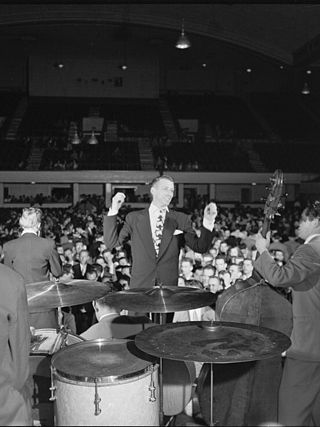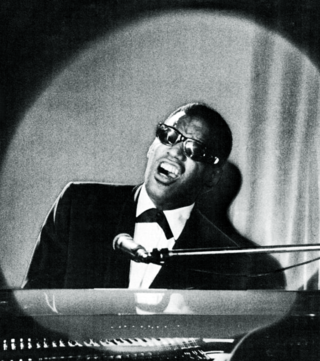Related Research Articles
Freestyle, or Latin freestyle is a form of electronic dance music that emerged in the New York metropolitan area Philadelphia, and Miami, primarily among Hispanic Americans and Italian Americans in the 1980s. It experienced its greatest popularity from the late 1980s until the early 1990s. A common theme of freestyle lyricism originated as heartbreak in an urban environment typified by New York City.
New wave is a music genre that encompasses pop-oriented styles from the 1970s through the 1980s. It is considered a lighter and more melodic "broadening of punk culture". It was originally used as a catch-all for the various styles of music that emerged after punk rock. Later, critical consensus favored "new wave" as an umbrella term involving many contemporary popular music styles, including synth-pop, alternative dance and post-punk. The main new wave movement coincided with late 1970s punk and continued into the early 1980s.

Progressive music is music that attempts to expand existing stylistic boundaries associated with specific genres of music. The word comes from the basic concept of "progress", which refers to advancements through accumulation, and is often deployed in the context of distinct genres, with progressive rock being the most notable example. Music that is deemed "progressive" usually synthesizes influences from various cultural domains, such as European art music, Celtic folk, West Indian, or African. It is rooted in the idea of a cultural alternative, and may also be associated with auteur-stars and concept albums, considered traditional structures of the music industry.
Rock is a broad genre of popular music that originated as "rock and roll" in the United States in the late 1940s and early 1950s, developing into a range of different styles from the mid-1960s, particularly in the United States and the United Kingdom. It has its roots in 1940s and 1950s rock and roll, a style that drew directly from the blues and rhythm and blues genres of African-American music and from country music. Rock also drew strongly from genres such as electric blues and folk, and incorporated influences from jazz and other musical styles. For instrumentation, rock has centered on the electric guitar, usually as part of a rock group with electric bass guitar, drums, and one or more singers. Usually, rock is song-based music with a 4
4 time signature using a verse–chorus form, but the genre has become extremely diverse. Like pop music, lyrics often stress romantic love but also address a wide variety of other themes that are frequently social or political. Rock was the most popular genre of music in the U.S. and much of the Western world from the 1950s to the 2010s.
Art rock is a subgenre of rock music that generally reflects a challenging or avant-garde approach to rock, or which makes use of modernist, experimental, or unconventional elements. Art rock aspires to elevate rock from entertainment to an artistic statement, opting for a more experimental and conceptual outlook on music. Influences may be drawn from genres such as experimental music, avant-garde music, classical music, and jazz.
Progressive rock is a broad genre of rock music that primarily developed in the United Kingdom through the mid- to late 1960s, peaking in the early 1970s. Initially termed "progressive pop", the style was an emergence of psychedelic bands who abandoned standard pop traditions in favour of instrumentation and compositional techniques more frequently associated with jazz, folk, or classical music. Additional elements contributed to its "progressive" label: lyrics were more poetic, technology was harnessed for new sounds, music approached the condition of "art", and the studio, rather than the stage, became the focus of musical activity, which often involved creating music for listening rather than dancing.

Soul music is a popular music genre that originated in the African American community throughout the United States in the late 1950s and early 1960s. It has its roots in African-American gospel music and rhythm and blues. Soul music became popular for dancing and listening, where U.S. record labels such as Motown, Atlantic and Stax were influential during the Civil Rights Movement. Soul also became popular around the world, directly influencing rock music and the music of Africa. It also had a resurgence in the mid-to late 1990s with the subgenre neo-soul, which added modern production elements and influence from hip-hop.
Synth-pop is a music genre that first became prominent in the late 1970s and features the synthesizer as the dominant musical instrument. It was prefigured in the 1960s and early 1970s by the use of synthesizers in progressive rock, electronic, art rock, disco, and particularly the Krautrock of bands like Kraftwerk. It arose as a distinct genre in Japan and the United Kingdom in the post-punk era as part of the new wave movement of the late 1970s.
Power pop is a subgenre of rock music and a form of pop rock based on the early music of bands such as the Who, the Beatles, the Beach Boys, and the Byrds. It typically incorporates melodic hooks, vocal harmonies, an energetic performance, and cheerful sounding music underpinned by a sense of yearning, longing, despair, or self-empowerment. The sound is primarily rooted in pop and rock traditions of the early-to-mid 1960s, although some artists have occasionally drawn from later styles such as punk, new wave, glam rock, pub rock, college rock, and neo-psychedelia.
Neo soul is a genre of popular music. As a term, it was coined by music industry entrepreneur Kedar Massenburg during the late 1990s to market and describe a style of music that emerged from soul and contemporary R&B. Heavily based in soul music, neo soul is distinguished by a less conventional sound than its contemporary R&B counterpart, with incorporated elements ranging from funk, jazz fusion, hip hop, and African music to pop, rock, and electronic music. It has been noted by music writers for its traditional R&B influences, conscious-driven lyrics, and strong female presence.
Popular music of the United Kingdom in the 1980s built on the post-punk and new wave movements, incorporating different sources of inspiration from subgenres and what is now classed as world music in the shape of Jamaican and Indian music. It also explored the consequences of new technology and social change in the electronic music of synthpop. In the early years of the decade, while subgenres like heavy metal music continued to develop separately, there was a considerable crossover between rock and more commercial popular music, with a large number of more "serious" bands, like The Police and UB40, enjoying considerable single chart success.
Blue-eyed soul is rhythm and blues (R&B) and soul music performed by white artists. The term was coined in the mid-1960s, to describe white artists whose sound was similar to that of the predominantly black Motown and Stax record labels. Though many R&B radio stations in the United States in that period would only play music by black musicians, some began to play music by white acts considered to have "soul feeling"; their music was then described as "blue-eyed soul".
Roots rock is a genre of rock music that looks back to rock's origins in folk, blues and country music. It is seen as responses to the perceived excesses of the dominant psychedelic and the developing progressive rock. Because roots music (Americana) is often used to mean folk and world musical forms, roots rock is sometimes used in a broad sense to describe any rock music that incorporates elements of this music. In the 1980s, roots rock enjoyed a revival in response to trends in punk rock, new wave, and heavy metal music.

American rock has its roots from 1940s and 1950s rock and roll, rhythm and blues, and country music, and also draws from folk music, jazz, blues, and classical music. American rock music was further influenced by the British Invasion of the American pop charts from 1964 and resulted in the development of psychedelic rock.

British rock describes a wide variety of forms of music made in the United Kingdom. Since around 1964, with the "British Invasion" of the United States spearheaded by the Beatles, British rock music has had a considerable impact on the development of American music and rock music across the world.

Dance music is music composed specifically to facilitate or accompany dancing. It can be either a whole piece or part of a larger musical arrangement. In terms of performance, the major categories are live dance music and recorded dance music. While there exist attestations of the combination of dance and music in ancient history, the earliest Western dance music that we can still reproduce with a degree of certainty are old-fashioned dances. In the Baroque period, the major dance styles were noble court dances. In the classical music era, the minuet was frequently used as a third movement, although in this context it would not accompany any dancing. The waltz also arose later in the classical era. Both remained part of the romantic music period, which also saw the rise of various other nationalistic dance forms like the barcarolle, mazurka, ecossaise, ballade and polonaise.
New pop is a loosely defined British-centric pop music movement consisting of ambitious, DIY-minded artists who achieved commercial success in the early 1980s through sources such as MTV. Rooted in the post-punk movement of the late 1970s, the movement spanned a wide variety of styles and artists, including acts such as Orange Juice, the Human League, and ABC. The term "rockist", a pejorative against people who shunned this type of music, coincided with and was associated with new pop.
Progressive pop is pop music that attempts to break with the genre's standard formula, or an offshoot of the progressive rock genre that was commonly heard on AM radio in the 1970s and 1980s. It was originally termed for the early progressive rock of the 1960s. Some stylistic features of progressive pop include hooks and earworms, unorthodox or colorful instrumentation, changes in key and rhythm, experiments with larger forms, and unexpected, disruptive, or ironic treatments of past conventions.
Progressive soul is a type of African-American music that uses a progressive approach, particularly in the context of the soul and funk genres. It developed in the late 1960s and early 1970s through the recordings of innovative black musicians who pushed the structural and stylistic boundaries of those genres. Among their influences were musical forms that arose from rhythm and blues music's transformation into rock, such as Motown, progressive rock, psychedelic soul, and jazz fusion.
References
- 1 2 Terich, Jeff; Blyweiss, Adam; Bossenger, A.T.; Prickett, Sam (24 April 2014). "10 Essential Sophisti-pop albums". Treble. Retrieved 9 May 2020.
- 1 2 3 "Pop/Rock » Punk/New Wave » Sophisti-Pop". AllMusic . Retrieved 21 October 2013.
- ↑ "9 different music genres in the internet age – 2/10 – Sophisti-Pop". The Economic Times . 7 September 2013. Retrieved 27 April 2016.
- ↑ Kirkham, Neil (2017). "Polluting young minds? Smash Hits and 'high Thatcherism'". Journal of European Popular Culture. 8 (2): 139–152. doi:10.1386/jepc.8.2.139_1 . Retrieved 13 December 2018.
'Sophisti-pop' (Inskeep and Soto 2007) is a term now used, retrospectively, to describe a collection of 'intelligent', lavishly produced British pop acts of the mid–late 1980s.
[ dead link ] - 1 2 3 4 Jenkins, Jake (30 July 2021). "Sophisti-pop: The '80s' Most Elegant Genre". Sweetwater. Retrieved 13 September 2022.
- ↑ Inskeep, Thomas; Soto, Alfred (22 February 2007). "The Bluffer's Guide – Sophisti-Pop". Stylus . Archived from the original on 4 September 2011. Retrieved 21 October 2013.
- ↑ Munn, Iain (2011) [1996]. Mr. Cool's Dream: The Complete History of The Style Council. Wholepoint. p. 23. ISBN 9780955144318.